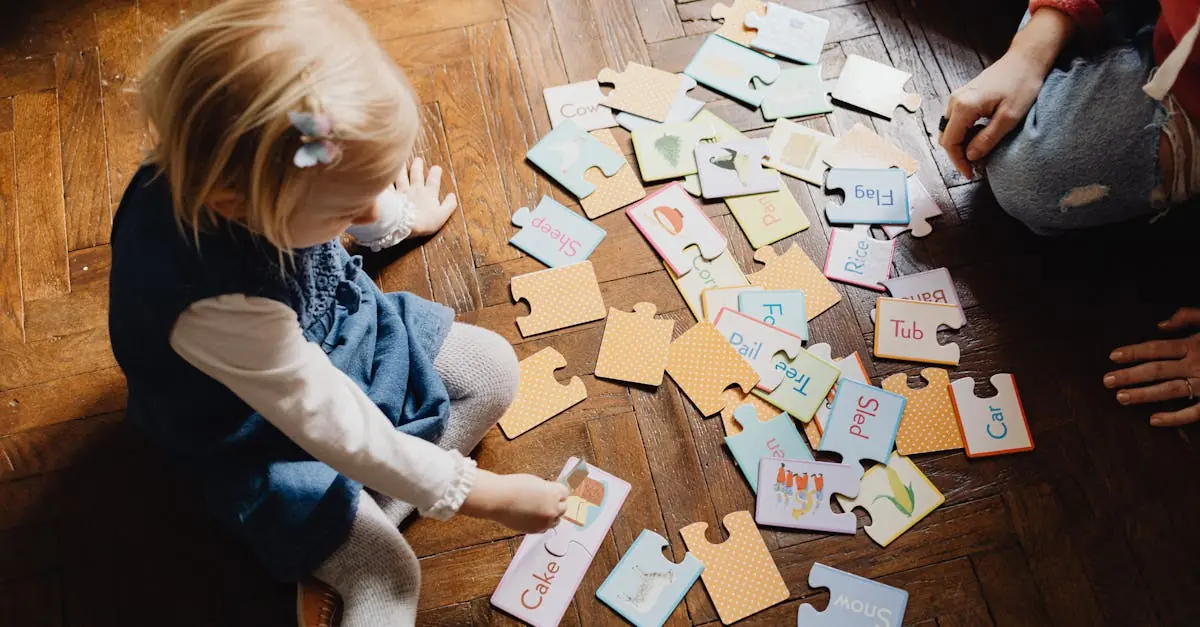Table of Contents
ToggleIn a world where kids can communicate with emojis better than with words, finding engaging language learning activities is crucial. Who knew that teaching children a new language could be as fun as a game of hide-and-seek? With the right activities, kids won’t just learn to speak—they’ll be shouting “¡Hola!” and “Bonjour!” like seasoned pros.
Overview of Language Learning Activities for Children
Engaging children in language learning activities enhances their communication skills. Interactive games promote vocabulary retention and encourage active participation. Storytelling fosters an appreciation for new cultures while enhancing comprehension.
Flashcards provide visual aids that help children associate words with images. Songs facilitate rhythm and pronunciation, making language learning more enjoyable. Crafts encourage creativity and can incorporate new vocabulary through hands-on experiences.
Role-playing scenarios allow children to practice language in real-life contexts. This method builds confidence and supports conversational skills. Apps designed for language learning can engage children through fun challenges and quizzes.
Group activities promote collaboration among peers. Children often learn effectively when working together on projects or games. Incorporating technology, like videos or interactive websites, captures their attention and offers diverse content.
Using everyday experiences for language practice reinforces learning. Simple tasks like shopping or cooking can introduce practical vocabulary. Regularly exposing children to new sounds and words helps solidify their understanding.
A variety of engaging language learning activities are available for children. Each activity serves to enhance their skills while keeping the learning process enjoyable.
Benefits of Language Learning Activities
Language learning activities offer numerous advantages for children. Engaging in these activities enhances cognitive abilities and social skills while fostering a love for language.
Cognitive Development
Cognitive development significantly benefits from language learning. Children improve memory, problem-solving, and critical thinking skills as they navigate new vocabulary and grammar. Studies indicate that exposure to multiple languages strengthens brain function and boosts academic performance, with bilingual children often outperforming their monolingual peers in reading and math. Additionally, learning a new language encourages creative thinking, as children explore different ways to express themselves. Enhanced cognitive skills lay a foundation for lifelong learning and adaptability in various environments.
Social Interaction
Social interaction receives a considerable boost through language learning activities. Engaging with peers fosters communication and cooperation, teaching children the value of teamwork. Role-playing scenarios help children practice conversational skills in real-world contexts, making them more comfortable in social situations. Collaborative games promote sharing and turn-taking, strengthening friendships and building empathy. Moreover, learning a new language exposes children to diverse cultures, enriching their understanding of the world and enhancing their ability to connect with others. This cultural appreciation nurtures respect and inclusivity among peers.
Types of Language Learning Activities
Language learning activities come in various forms, each designed to engage children while building essential language skills. Here are some effective types of activities:
Interactive Games
Interactive games keep children motivated and make language learning fun. Language-focused board games encourage vocabulary use and turn learning into an exciting competition. Digital apps often include games that reinforce language concepts through quizzes and interactive storytelling. Bingo games featuring vocabulary words or phrases enhance retention while fostering teamwork. By incorporating movement, scavenger hunts encourage children to practice language skills in a dynamic environment.
Storytelling and Reading Aloud
Storytelling and reading aloud serve as powerful tools for language development. Encouraging children to narrate their own stories stimulates creativity and language construction. Engaging with diverse books introduces new vocabulary and cultural perspectives, enhancing comprehension. Visual aids such as illustrations aid in understanding plot and context, making the experience more relatable. Discussing stories afterward reinforces critical thinking and encourages dialogue about different themes.
Arts and Crafts
Arts and crafts offer hands-on ways for children to explore language. Crafting projects that require following verbal and written instructions improve understanding and vocabulary. Creating visual representations of new words helps solidify their meanings, making them memorable. Incorporating language into projects reinforces learning through creativity. Group crafts foster collaboration, allowing children to communicate effectively while sharing ideas and materials.
Strategies for Effective Language Learning
Engaging children in language learning requires effective strategies. Utilizing diverse methods enhances comprehension and retention.
Incorporating Technology
Technology offers numerous interactive tools that make language learning enjoyable. Language learning apps provide gamified experiences, motivating kids to practice regularly. They encourage daily challenges and rewards, fostering consistent engagement. Additionally, online quizzes and videos expose children to authentic language use, aiding listening skills. Interactive websites serve as platforms for practice beyond the classroom, connecting children with peers globally. Each resource offers structured learning paths suited for various skill levels.
Creating a Language-rich Environment
A language-rich environment supports ongoing language development. Surrounding children with books, labels, and visual aids enhances vocabulary recognition. Regular conversations about daily activities create opportunities for language use and comprehension. Parents and educators can engage in discussions that encourage open-ended responses, promoting critical thinking. Incorporating music and storytelling into routines fosters an appreciation for language rhythm and structure. Each interaction contributes to a vibrant language atmosphere that nurtures curiosity and exploration.
Engaging children in language learning activities opens up a world of possibilities. By incorporating fun and interactive methods, kids can develop essential communication skills while enjoying the process. From games and storytelling to crafts and technology, these activities not only enhance language proficiency but also foster creativity and critical thinking.
Creating a language-rich environment further supports children’s learning journey. As they explore new languages through everyday experiences, they build confidence and social skills that benefit them academically and personally. Embracing these diverse approaches ensures that language learning remains an exciting adventure, paving the way for lifelong curiosity and understanding of different cultures.




